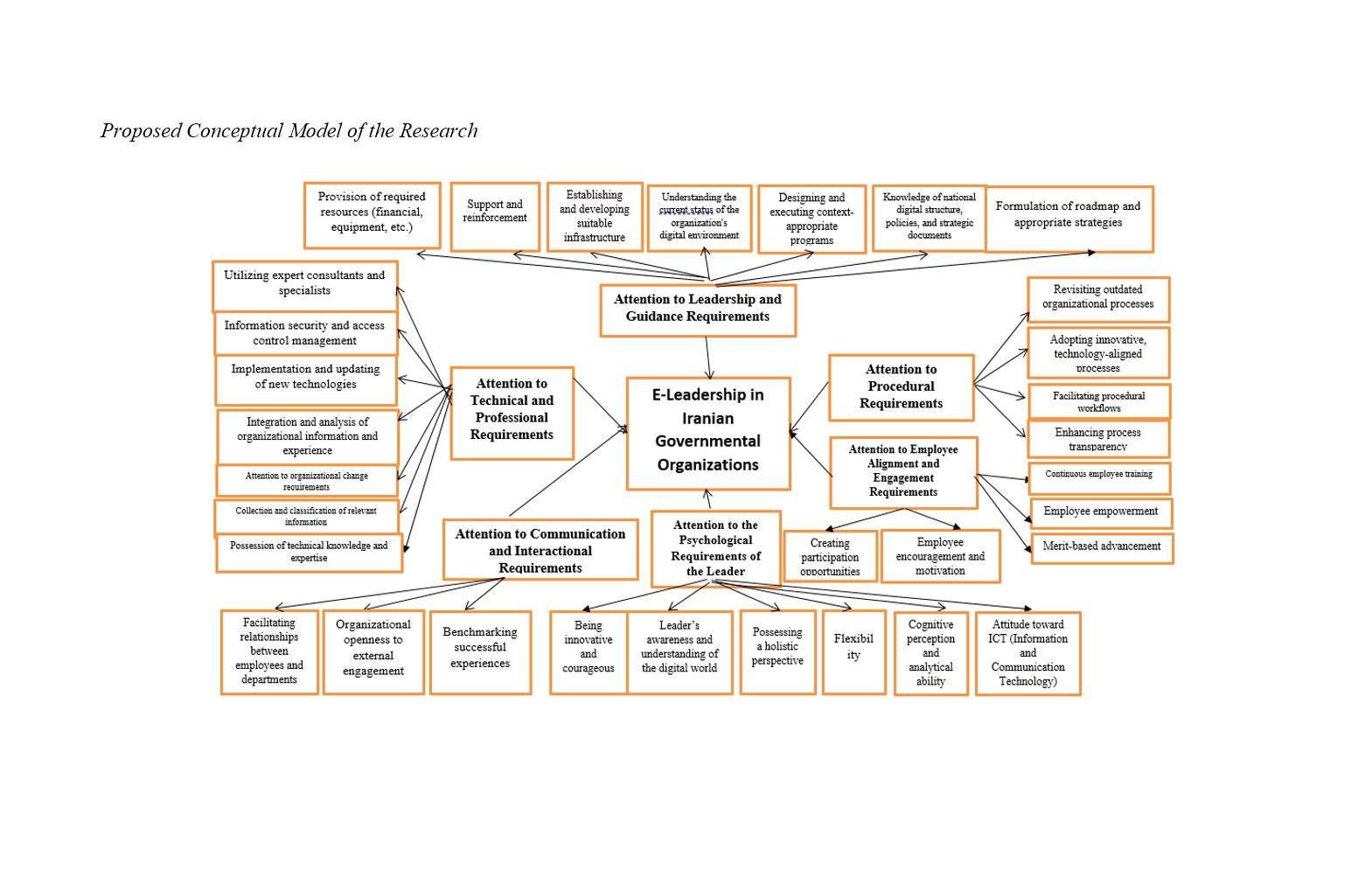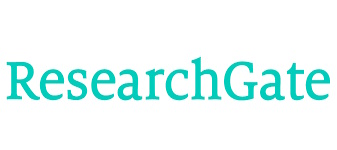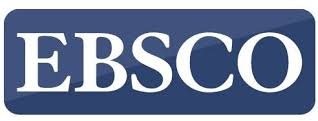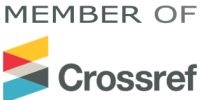Proposing a Conceptual Model of E-Leadership in Iranian Governmental Organizations
Keywords:
Conceptual Model, E-Leadership , Governmental Organizations, IranAbstract
This study was conducted with the aim of proposing a conceptual model of e-leadership in Iranian governmental organizations. The research method employed in the present study was exploratory, and the research strategy was qualitative, based on the application of a phenomenological approach. Utilizing semi-structured interviews, the study explored the perspectives, experiences, and insights of scholars and experts to identify the dimensions and components influencing e-leadership, ultimately resulting in the development of a conceptual model. The research participants included academic experts (with a minimum of 10 years of faculty experience and holding at least an assistant professorship) and active managers in governmental organizations (with a minimum of 10 years of managerial experience in the public sector). A non-probability purposive judgmental sampling method was used to select participants. Sampling continued until theoretical saturation was reached, and the researcher was ultimately able to conduct interviews with 14 individuals. The findings derived from the interview text analysis—based on the phenomenological approach and a three-stage coding process (open, axial, and selective coding)—revealed that six dimensions (main categories) and 32 components (subcategories) are influential in shaping the e-leadership model in Iranian governmental organizations. These dimensions include: (1) attention to leadership and guidance requirements (comprising 7 components), (2) attention to technical and professional requirements (comprising 7 components), (3) attention to communication and interactional requirements (comprising 3 components), (4) attention to the psychological requirements of the leader (comprising 6 components), (5) attention to the requirements for employee alignment and synchronization (comprising 3 components), and (6) attention to procedural requirements (comprising 4 components).
References
AlAjmi, M. K. (2022). The impact of digital leadership on teachers' technology integration during the COVID-19 pandemic in Kuwait. International Journal of Educational Research, 112, 101928. https://doi.org/10.1016/j.ijer.2022.101928
Amelda, B., Alamsjah, F., & Elidjen, E. (2021). Does The Digital Marketing Capability of Indonesian Banks Align with Digital Leadership and Technology Capabilities on Company Performance? Commit (Communication and Information Technology) Journal, 15(1), 9-17. https://doi.org/10.21512/commit.v15i1.6663
Antonopoulou, H., Matzavinou, P., Γιαννούκου, Ι., & Halkiopoulos, C. (2025). Teachers’ Digital Leadership and Competencies in Primary Education: A Cross-Sectional Behavioral Study. Education Sciences, 15(2), 215. https://doi.org/10.3390/educsci15020215
Anwar, N. A. (2025). How Digital Leadership Drives Innovation and Competitive Advantage In. SSRN Electronic Journal. https://doi.org/10.2139/ssrn.5124169
Artüz, S. D., & Bayraktar, O. (2021). The effect of relation between digital leadership practice and learning organization on the perception of individual performance. İstanbul Ticaret Üniversitesi Sosyal Bilimler Dergisi, 20(40), 97-120. https://doi.org/10.46928/iticusbe.761479
Asfahani, A. M. (2025). Navigating Digital Leadership: Unraveling the Dynamics of Remote Work Environments. Tem Journal, 823-835. https://doi.org/10.18421/tem141-73
Baglama, B., Evcimen, E., Altinay, F., Sharma, R. C., Tlili, A., Altinay, Z., & Celebi, M. (2022). Analysis of Digital Leadership in School Management and Accessibility of Animation-Designed Game-Based Learning for Sustainability of Education for Children with Special Needs. Sustainability, 14(13), 7730. https://doi.org/10.3390/su14137730
Banks, G. C., Dionne, S. D., Mast, M. S., & Sayama, H. (2022). Leadership in the digital era: A review of who, what, when, where, and why. The Leadership Quarterly, 101634. https://doi.org/10.1016/j.leaqua.2022.101634
Cortellazzo, L., Bruni, E., & Zampieri, R. (2019). The role of leadership in a digitalized world: a review. Frontiers in psychology, 10, 1-21. https://doi.org/10.3389/fpsyg.2019.01938
Ertanto, B., Bangun, W., & Tjandrasa, B. B. (2025). Bridging the Digital Divide: The Impact of Digital Leadership on Career Commitment With Work Engagement as a Mediator in the Hospitality Sector. Journal of Economics Finance and Management Studies, 08(01). https://doi.org/10.47191/jefms/v8-i1-37
Ghaedamini Harouni, A., Mehrdad Sadeghi, D. C. S., Korang Beheshti, S., & Maherani Barzani, M. (2019). The Impact of Electronic Leadership on Commitment to Change Through Perceived Quality of Change Communication and Readiness for Change. Behavioral Studies in Management, 10(19), Spring-Summer. https://www.sciencedirect.com/science/article/abs/pii/S1447677021001145
Ghavifekr, S., & Wong, S. Y. (2022). Technology leadership in Malaysian schools: The way forward to education 4.0-ICT utilization and digital transformation. International Journal of Asian Business and Information Management (IJABIM), 13(2), 1-18. https://doi.org/10.4018/IJABIM.20220701.oa3
Kargar Shorki, M., Vares, S. H., & Ghaffari, A. (2022). Digital Sustainability Competencies of Business Leaders for the Implementation of the Fourth Industrial Revolution. Journal of the Iranian Management Science Association, 17(67), 133-103. https://hrcak.srce.hr/ojs/index.php/entrenova/article/view/14236
Khodadadi, A., & Abbaspour, A. (2022). Modeling Digital Governance in Virtual Organizations in the Public Sector: A Case Study of the Social Security Organization. Journal of Iranian Political Sociology, 5(12), 3231-3246. https://jou.spsiran.ir/article_158397.html?lang=en
Kiakojouri, D. (2024). Analysis of the relationships among Organizational Culture Indicators Using the DEMATEL Method at the Islamic Azad University in the West of Mazandaran Province. Journal of Dynamic Management Business Analysis, 2(4), 1-12. https://doi.org/10.61838/dmbaj.2.4.1
Liu, C., VanWart, M., Kim, S., Wang, X., McCarthy, A., & Ready, D. (2020). The effects of national cultures on two technologically advanced countries: The case of e-leadership in South Korea and the United States. Aust J Publ Admin., 1-32. https://doi.org/10.1111/1467-8500.12433
Maheshwari, G., Clarke, S., Nguyen, Q. A. N., McClelland, R., & Kunte, M. (2024). Effect of E-leadership on employees' outcomes in the higher education sector during COVID-19 and beyond: A case study from VietnamJO - Educational Management Administration & Leadership. 17411432231222715. https://doi.org/10.1177/17411432231222715
Mahmoodi Fard, A., & Maleki, A. (2023). Investigating the Impact of Governance and Electronic Leadership on Public Administration. Proceedings of the 3rd International Conference on Applied Research in Management, Accounting, Economics, and Industrial Engineering,
Mergel, I., Edelmann, N., & Haug, N. (2019). Defining digital transformation: Results from expert interviews. Government Information Quarterly, 36(4), 101-125. https://doi.org/10.1016/j.giq.2019.06.002
Nasrun, M. K. (2025). Accelerating Digital Transformation Through Digital Leadership: Strategies for Innovation, Sustainability, and Organisational Performance Enhancement. Bisma (Bisnis Dan Manajemen), 264-291. https://doi.org/10.26740/bisma.v17n2.p264-291
Norouzi, H., Nosratpanah, R., & Barani, S. (2022). The Impact of Digital Leadership on Company Performance in Dynamic Environments: The Role of Dynamic Capabilities, Business Model Innovation, and Sustainable Competitive Advantage. Business Management, 14(3), 474-445. https://www.researchgate.net/
Rastegar, A., Manafi Varkiani, M., Roufi, M., & Hemmati, A. (2023). Explaining the Role of Electronic Leadership on E-Government Governance (with an Approach to the Seventh National Development Plan). Proceedings of the 6th International Conference on New Developments in Management, Economics, and Accounting, Tehran,
Sasmoko, S., Mihardjo, L., Alamsjah, F., & Elidjen, E. (2019). Dynamic capability: The effect of digital leadership on fostering innovation capability based on market orientation. Management Science Letters, 9(10), 1633-1644. https://doi.org/10.5267/j.msl.2019.5.024
Shah Hosseini, M. A., Shami Zanjani, M., & Abedin, B. (2019). Designing a Conceptual Framework for Digital Transformation Leadership in Iranian Organizations. Management and Planning in Educational Systems, 12(2), 211-242. https://doi.org/10.29252/mpes.12.2.211
Susilowati, Y. T. (2025). Optimizing Protocol Performance in the Digital Era: A Study of the Integration of Digital Leadership, Change Management, and Personal Competence in the Protocol Scope. Proceeding of the International Conference on Economics and Business, 3(2), 59-76. https://doi.org/10.55606/iceb.v3i2.448
Toutian Esfahani, S., Rajabifarjad, H., & Amini Khanavandi, F. (2024). Identifying the Dimensions of Electronic Leadership in the Educational System with an Emphasis on Crisis Conditions. Studies in Educational Measurement and Evaluation. https://jresearch.sanjesh.org/article_713218.html?lang=en
Wasono, L. W., & Furinto, A. (2018). The effect of digital leadership and innovation management for incumbent telecommunication company in the digital disruptive era. International Journal of Engineering and Technology, 7, 125-130. https://doi.org/10.14419/ijet.v7i2.29.13142
Wiyono, B. B., Komariah, A., Alghamdi, A. A., & Fahlevi, M. (2023). The influence of principals'e-leadership on the effectiveness of schools' public relations and organizational improvement. Sustainability, 15(2), 1296. https://doi.org/10.3390/su15021296
Yasemi, Z., Kheiri, A., & Rezaei, S. (2023). Digital Leadership Strategies in Sports Organizations and Their Impact in Individual and Organizational Arenas. Proceedings of the 2nd International Conference of Students of Sport Sciences and Physical Education, Tehran,

Downloads
Published
Submitted
Revised
Accepted
Issue
Section
License
Copyright (c) 2025 Ehsan Cheshmishi (Author); Fareydoun Ahmadi; Adel Salavati (Author)

This work is licensed under a Creative Commons Attribution-NonCommercial 4.0 International License.









